Layton ServiceDesk - Settings - Company Structure - Manage Company
m (Jpainter moved page Layton ServiceDesk™ - Settings - Company Structure - Manage Company to Layton ServiceDesk - Settings - Company Structure - Manage Company: Removed the TM symbol for a cleaner URL) |
m (Updated links) |
||
| Line 1: | Line 1: | ||
| − | <p align="right">[[File:btn_back_up.png|link=User Guide for Layton | + | <p align="right">[[File:btn_back_up.png|link=User Guide for Layton ServiceDesk]] [[User Guide for Layton ServiceDesk|<u>Back to Contents</u>]]</p> |
| − | <p align="right">[[File:btn_back_up.png|link=Layton | + | <p align="right">[[File:btn_back_up.png|link=Layton ServiceDesk - Settings - Company Structure - Manage Site]] [[Layton ServiceDesk - Settings - Company Structure - Manage Site |<u>Previous article in this series: ''Manage Site''</u>]]</p> |
=Overview= | =Overview= | ||
| − | Most ServiceDesks generally provide support services for End Users within their own organization. However, if your ServiceDesk will be providing support services to external or third party companies, Layton ServiceDesk has the ability to create multiple Company identities, then End Users may be assigned to their respective companies. The default Layton ServiceDesk installation has the Company Level feature disabled. If your ServiceDesk will be providing support to external or third party companies, then you can turn on the '''[[Layton | + | Most ServiceDesks generally provide support services for End Users within their own organization. However, if your ServiceDesk will be providing support services to external or third party companies, Layton ServiceDesk has the ability to create multiple Company identities, then End Users may be assigned to their respective companies. The default Layton ServiceDesk installation has the Company Level feature disabled. If your ServiceDesk will be providing support to external or third party companies, then you can turn on the '''[[Layton ServiceDesk - Settings - System Settings - Application Settings#Company Level|Company Level]]''' in '''Administration > System Settings > Application Settings'''. Once this is turned on, you may define your Companies under Administration > Company Structure > Manage Company. |
| Line 15: | Line 15: | ||
| − | The Company Id field is where the Company is defined with a single identifier which must be unique. The contact information is available to enter the Company's mailing address, email address, phone number, etc. Like most forms in ServiceDesk, this can be modified to include more fields to meet the needs of your organization. User-defined fields must first be added in '''[[Layton | + | The Company Id field is where the Company is defined with a single identifier which must be unique. The contact information is available to enter the Company's mailing address, email address, phone number, etc. Like most forms in ServiceDesk, this can be modified to include more fields to meet the needs of your organization. User-defined fields must first be added in '''[[Layton ServiceDesk - Configuring the System - Data Design|Administration > Data Design > Company Data]]''', then they may be added to the form in Administration > Form Design > Company. |
| − | <p align="right">[[File:btn_back_up.png|link=User Guide for Layton | + | <p align="right">[[File:btn_back_up.png|link=User Guide for Layton ServiceDesk]] [[User Guide for Layton ServiceDesk|<u>Back to Contents</u>]]</p> |
=Settings= | =Settings= | ||
The Company settings provide options for email notification settings. | The Company settings provide options for email notification settings. | ||
| Line 24: | Line 24: | ||
| − | + | ==Mail Analyst Group When Over Requests Assigned== | |
| − | + | When the number of Requests associated with this Company is greater than this specified value, an email is sent to the Analyst Group specified below | |
| − | + | ||
| − | + | ==Mail Analyst Group== | |
| − | + | The email notification will be sent to this Analyst Group | |
| − | + | ||
| − | + | ==Mail Analyst Group Every== | |
| − | + | The email notification may be scheduled to send on an interval based on the number of days specified | |
| − | + | ||
| − | + | ||
| − | + | ||
| − | + | ||
| − | + | ||
| − | + | ||
=Working Hours= | =Working Hours= | ||
| Line 46: | Line 40: | ||
| − | The Priority/SLA time only elapses during Working Hours, given there are no scheduled '''[[#Closed Period|Closed Periods]]''' during that time. Any Request submitted will have Priority/SLA escalation levels working within the End User Company's Working Hours setting. The Company-specific Working Hours will supersede the global '''[[Layton | + | The Priority/SLA time only elapses during Working Hours, given there are no scheduled '''[[#Closed Period|Closed Periods]]''' during that time. Any Request submitted will have Priority/SLA escalation levels working within the End User Company's Working Hours setting. The Company-specific Working Hours will supersede the global '''[[Layton ServiceDesk - General Settings - Default Working Hours|Default Working Hours]]'''. If the companies you support span multiple time zones, or have different Working Hours, then it can be beneficial to use Company-specific Working Hours settings, as the global Default Working Hours will not apply to everyone. |
| − | <p align="right">[[File:btn_back_up.png|link=User Guide for Layton | + | <p align="right">[[File:btn_back_up.png|link=User Guide for Layton ServiceDesk]] [[User Guide for Layton ServiceDesk|<u>Back to Contents</u>]]</p> |
=Closed Periods= | =Closed Periods= | ||
Combined with '''[[#Working Hours|Working Hours]]''', Closed Periods control the Company's office hours. Any hours that fall within a scheduled Closed Period will not count against the Requests' Priority/SLA times. | Combined with '''[[#Working Hours|Working Hours]]''', Closed Periods control the Company's office hours. Any hours that fall within a scheduled Closed Period will not count against the Requests' Priority/SLA times. | ||
| Line 54: | Line 48: | ||
=Email= | =Email= | ||
| − | The optional email setting provides for the configuration of unique email server settings for each Company in your ServiceDesk. Please refer to the global '''[[Layton | + | The optional email setting provides for the configuration of unique email server settings for each Company in your ServiceDesk. Please refer to the global '''[[Layton ServiceDesk - Settings - System Settings - Email Server Settings|Email Server Settings]]''' for a detailed description of the ServiceDesk email configuration process. |
| Line 60: | Line 54: | ||
| − | The Company-specific email configuration allows for custom email server connection information specific to each Company. All settings are inherited from the global '''[[Layton | + | The Company-specific email configuration allows for custom email server connection information specific to each Company. All settings are inherited from the global '''[[Layton ServiceDesk - Settings - System Settings - Email Server Settings|Email Server Settings]]''' until they are customized, then the Company-specific configuration will take precedence. This includes the Auto Import settings, which default to ''Inherited'', but they may also be turned ''On'' or ''Off''. |
=Delete= | =Delete= | ||
Use the delete button to remove a Company that is no longer in use. | Use the delete button to remove a Company that is no longer in use. | ||
| − | <p align="right">[[Layton | + | <p align="right">[[Layton ServiceDesk - Settings - Company Structure - Manage CAB Group |<u>Next article in this series: ''Manage CAB Group''</u>]] [[File:Btn forward.png|link=Layton ServiceDesk - Settings - Company Structure - Manage CAB Group]]</p> |
| − | <p align="right">[[File:btn_back_up.png|link=User Guide for Layton | + | <p align="right">[[File:btn_back_up.png|link=User Guide for Layton ServiceDesk]] [[User Guide for Layton ServiceDesk|<u>Back to Contents</u>]]</p> |
Latest revision as of 04:05, 9 September 2016
![]() Previous article in this series: Manage Site
Previous article in this series: Manage Site
Contents |
[edit] Overview
Most ServiceDesks generally provide support services for End Users within their own organization. However, if your ServiceDesk will be providing support services to external or third party companies, Layton ServiceDesk has the ability to create multiple Company identities, then End Users may be assigned to their respective companies. The default Layton ServiceDesk installation has the Company Level feature disabled. If your ServiceDesk will be providing support to external or third party companies, then you can turn on the Company Level in Administration > System Settings > Application Settings. Once this is turned on, you may define your Companies under Administration > Company Structure > Manage Company.

[edit] Properties
The default Company properties consist of the Company Id and the Company's contact information.
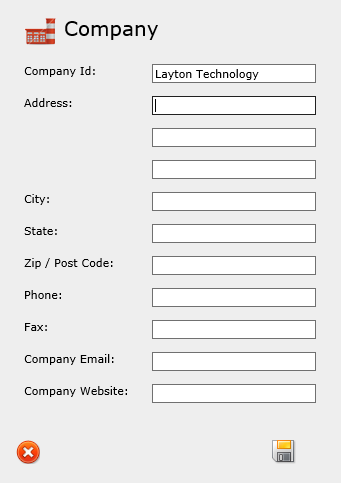
The Company Id field is where the Company is defined with a single identifier which must be unique. The contact information is available to enter the Company's mailing address, email address, phone number, etc. Like most forms in ServiceDesk, this can be modified to include more fields to meet the needs of your organization. User-defined fields must first be added in Administration > Data Design > Company Data, then they may be added to the form in Administration > Form Design > Company.
[edit] Settings
The Company settings provide options for email notification settings.
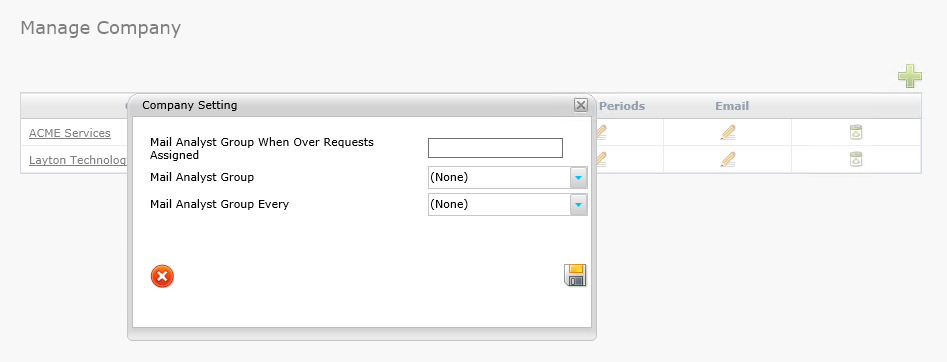
[edit] Mail Analyst Group When Over Requests Assigned
When the number of Requests associated with this Company is greater than this specified value, an email is sent to the Analyst Group specified below
[edit] Mail Analyst Group
The email notification will be sent to this Analyst Group
[edit] Mail Analyst Group Every
The email notification may be scheduled to send on an interval based on the number of days specified
[edit] Working Hours
The Company-specific Working Hours allows for a granular configuration of working hours in your organization. To specify the Working Hours, a start time and an end time is entered for each day of the week:
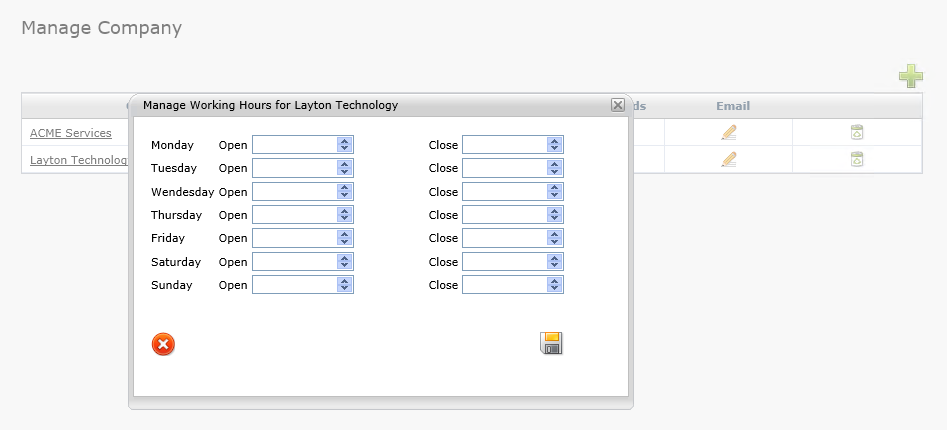
The Priority/SLA time only elapses during Working Hours, given there are no scheduled Closed Periods during that time. Any Request submitted will have Priority/SLA escalation levels working within the End User Company's Working Hours setting. The Company-specific Working Hours will supersede the global Default Working Hours. If the companies you support span multiple time zones, or have different Working Hours, then it can be beneficial to use Company-specific Working Hours settings, as the global Default Working Hours will not apply to everyone.
[edit] Closed Periods
Combined with Working Hours, Closed Periods control the Company's office hours. Any hours that fall within a scheduled Closed Period will not count against the Requests' Priority/SLA times.
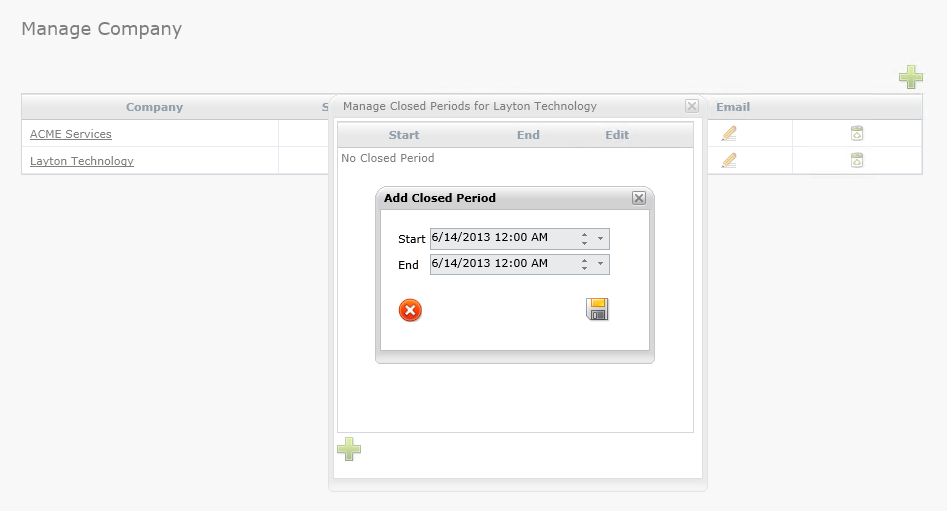
[edit] Email
The optional email setting provides for the configuration of unique email server settings for each Company in your ServiceDesk. Please refer to the global Email Server Settings for a detailed description of the ServiceDesk email configuration process.
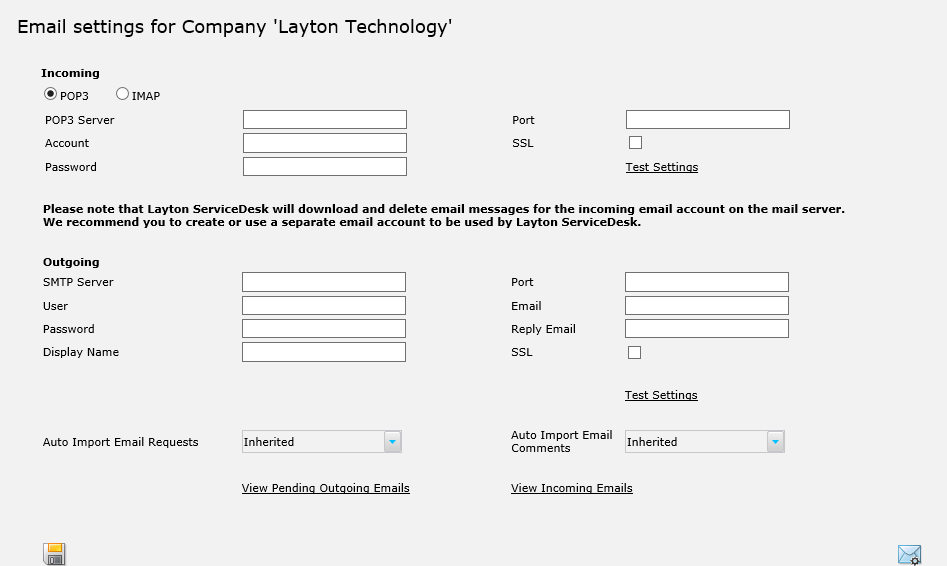
The Company-specific email configuration allows for custom email server connection information specific to each Company. All settings are inherited from the global Email Server Settings until they are customized, then the Company-specific configuration will take precedence. This includes the Auto Import settings, which default to Inherited, but they may also be turned On or Off.
[edit] Delete
Use the delete button to remove a Company that is no longer in use.